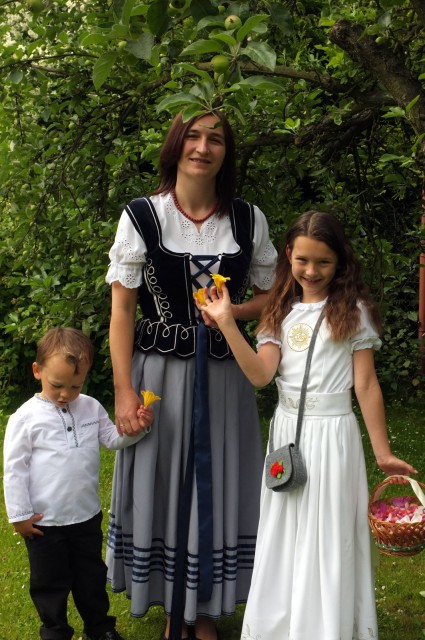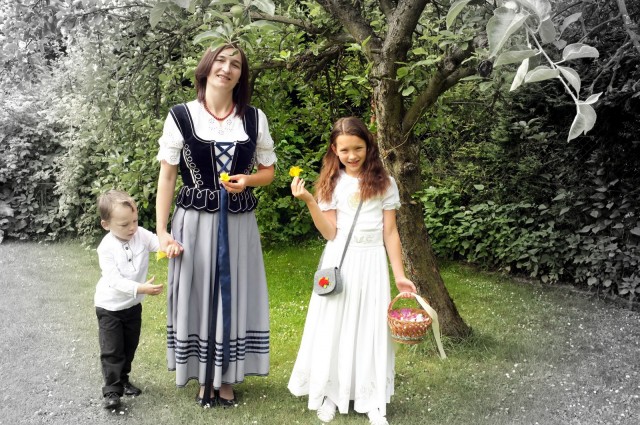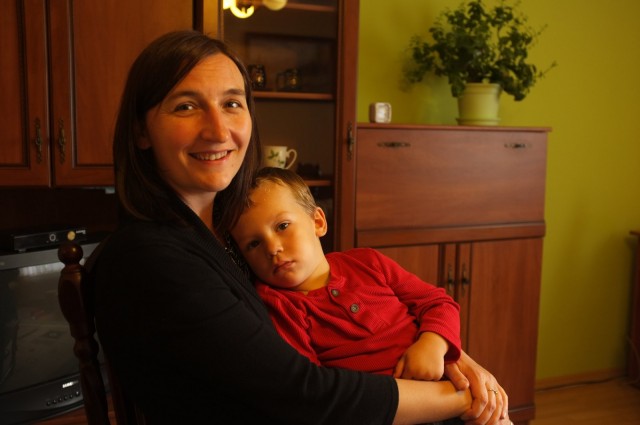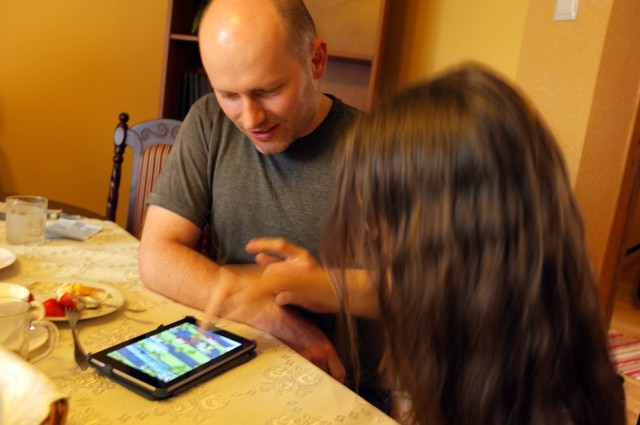Because almost every village is its own parish, almost every village has an odpust. During the last trip to Poland, we were in Pyzówka for their odpust. We were there strictly as visitors, as observers.
Today, however, the Girl got to participate in Jabłonka’s odpust, as did K.
“I cleaned the church!” K told me, relating her part of the experience. The excitement came from the fact that she cleaned the altar, dusting and wiping down all the statuary that’s part of Jabłonka’s main church’s impressive altar piece. It’s something she’d looked at all her life growing up, so I guess seeing it all so up close, from a different perspective both literally and figuratively, was certainly exciting.
L’s part, though was as visible as K’s was behind-the-scenes: she was helped lead the procession to the church, sprinkling flowers before the priests and dignified guests as they processed. The whole experience must certainly be novel to the Girl, for even though we’re members of a vibrant and active parish here in Greenville, there’s not a lot of processing going on, not of this nature. And besides, how would everyone treat that?
In Jabłonka — and elsewhere in Poland — everyone treats it as such a special occasion that all the traditional garb comes out and it becomes a visually lovely experience. In America, everyone would come out in shorts and flipflops because in the summer, that’s about as close as we come to traditional garb. It’s one of the disadvantages of living in such a relatively young country that has, for generations, been much more mobile than the Old Country. We mix and match and before you know it, any sense of tradition that stretches back into the mists of memory have disappeared. The only people that hold to that are the Native Americans (who often have to fight on onslaught of competing cultures that see themselves as somehow extensions of that very culture) and the minority populations, Asian, South American, and to some degree African. It’s a sad thing, but perhaps somewhat unavoidable, given our history and our lack of homogeneity.
But Poland, especially in the rural areas of the mountains, really exemplifies homogeneity. It was something that took some getting used to when I first moved to Lipnica Wielka, which is just about seven or eight kilometers from K’s home village of Jabłonka. Everywhere I looked I saw homogeneity: white people speaking a single language. When, on a trip to Warsaw, I saw African students in the the main train station, I almost wanted to hug them and say, “Let me just look at you! It’s so refreshing to see some diversity again!” When I saw a young Asian girl and a black girl on a popular TV series, both speaking flawless Polish, I became enthralled, wanting to learn everything I could about them. Heterogeneity was so rare that I just gawked at it.
That was the Poland of the latter mid-90s. Twenty years on, so much has changed. Emigration from Poland has increased with the open EU borders, creating a certain brain drain as many of the more educated young adults move west, and immigration from the east, often illegal, has increased as well, as people from the former Soviet republics move to their own West, which is now Poland. And about all that, I have mixed feelings. I know that Poland will never become America, ethnically speaking, but might it become Germany? France? Diversity is a wonderful thing, but as with everything, it comes with a certain price. Still, I don’t see the highlanders of southern Poland diluting their own culture and pride in it at all for anyone.
Not that I’m suggesting anyone would try to dilute it — it’s just a byproduct, I think, of competing cultures. Not so for the gorals of the south: they’d cling to it ferociously, ever more mindful of the competition. And to some degree, that competition, with the level playing field that the Internet creates, already exists.
Back to the story: after odpust, everyone went to aunty’s for dinner. And it was a huge feast, in keeping with the Polish saying, “A guest in the house is God in the house.” And even though they’re family, K and the kids are still guests, and the Polish spirit demands sharing on a massive scale.
L hit it off with K’s cousin, R, who is a technophile as L is becoming. She loves showing people how to play this game or that game on the family tablet, which, truth be told, is more hers than anyone else’s.
When L and I were there two years ago, we attended R’s and M’s wedding — our daughter’s first experience with a Polish wedding. As a girl who loves — absolutely loves — dancing, she was hooked immediately.
There’s another family wedding coming up in mid-July, one which I’m hoping to attend myself. Still no decision yet: the to-do list still has a lot to get done, but maybe. Hopefully.









0 Comments